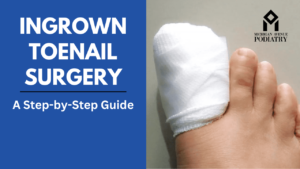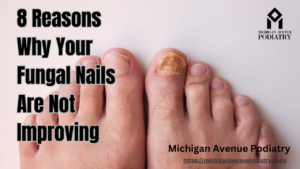Gout is a type of arthritis characterized by sudden and severe attacks of pain, swelling, and redness in the joints, most commonly affecting the big toe. These painful episodes, known as gout attacks, can be debilitating and significantly impact daily activities. While gout cannot be cured, there are steps you can take to manage symptoms and reduce the frequency and severity of attacks. In this blog post, we’ll explore ten effective strategies for easing a gout attack, with insights from podiatrists and foot doctors.
Understanding Gout and Its Symptoms:
Before delving into the steps to ease a gout attack, let’s briefly review the symptoms and causes of gout. Gout is caused by the buildup of uric acid in the blood, which forms crystals that deposit in the joints, leading to inflammation and pain. Common symptoms of gout include:
- Sudden onset of intense joint pain, often in the big toe can also affect other joints such as the ankles, knees, elbows, and wrists.
- Swelling and redness around the affected joint.
- Tenderness and warmth to the touch.
- Limited range of motion in the joint.
Now, let’s explore ten steps you can take to ease the discomfort of a gout attack:
- Rest the Affected Joint:
During a gout attack, it’s essential to rest the affected joint to reduce inflammation and minimize pain. Avoid putting weight on the joint and refrain from activities that may exacerbate the pain, such as walking or standing for prolonged periods.
- Apply Ice Packs:
Applying ice packs to the affected joint can help alleviate pain and reduce swelling during a gout attack. Wrap an ice pack or a bag of frozen peas in a thin towel and apply it to the joint for 15-20 minutes at a time, several times a day.
- Stay Hydrated:
Drinking plenty of water can help flush excess uric acid from the body, potentially reducing the duration and severity of a gout attack. Aim to drink at least 8-10 glasses of water per day, and limit your intake of sugary beverages and alcohol, which can exacerbate gout symptoms.
- Elevate the Affected Limb:
Elevating the affected limb above heart level can help reduce swelling and improve circulation to the joint. Prop up your leg on pillows or cushions whenever you’re resting or lying down to promote drainage of excess fluid from the area.
- Take Over-the-Counter Pain Medications:
Over-the-counter nonsteroidal anti-inflammatory drugs (NSAIDs) such as ibuprofen or naproxen can help alleviate pain and inflammation during a gout attack. Follow the dosing instructions on the package carefully and consult with your healthcare provider if you have any concerns.
- Avoid Trigger Foods:
Certain foods and beverages high in purines can increase uric acid levels in the blood and trigger gout attacks. Avoid or limit consumption of purine-rich foods such as red meat, organ meats, shellfish, sugary drinks, and alcohol during a gout attack.
- Use Assistive Devices:
If walking or standing is painful during a gout attack, consider using assistive devices such as crutches or a cane to offload weight from the affected joint and improve mobility. Supportive footwear with cushioning and shock absorption can also help reduce pressure on the joints.
- Try Natural Remedies:
Some individuals find relief from gout symptoms by using natural remedies such as cherry juice, bromelain (an enzyme found in pineapple), or ginger. While research on the effectiveness of these remedies is limited, they may provide some relief for certain individuals.
- Maintain a Healthy Weight:
Excess weight can increase the risk of gout and exacerbate symptoms during a gout attack. Maintain a healthy weight through a balanced diet and regular exercise to reduce the burden on your joints and improve overall health.
- Consult with a Podiatrist or Foot Doctor:
If you experience frequent or severe gout attacks, it’s essential to consult with a podiatrist or foot doctor for personalized treatment and management strategies. They can help identify triggers, prescribe medications to prevent future attacks, and provide guidance on lifestyle modifications to manage gout effectively.
Conclusion:
Gout attacks can be excruciatingly painful and disruptive, but with proper management strategies, you can ease symptoms and reduce the frequency of attacks. By following these ten steps, including rest, ice therapy, hydration, medication, and lifestyle modifications, you can effectively manage gout attacks and improve your quality of life. If you experience persistent or severe gout symptoms, don’t hesitate to seek guidance from a podiatrist or foot doctor for personalized care and treatment. With the right approach, you can take control of your gout and minimize its impact on your daily activities.





Thank you for some other magnificent post. Where else may anybody get that type of information inn such
an ideal approach of writing? I’ve a presentation next week,
and I am at the search for such information.